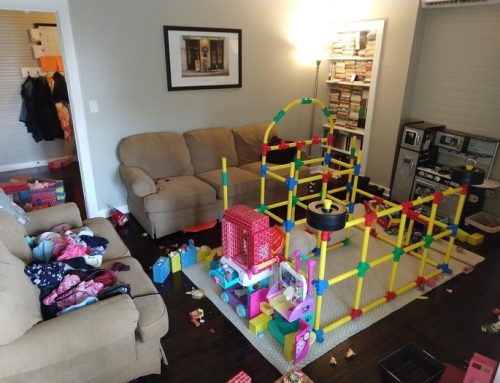Before I had two kids in two years, I thought I had my time pretty well dialed in. Before they arrived, I would have thought, “Sure, take back your time, yup, it’s great, been there, done that.” After the kids came, I saw how far I had left to go.
The truth is that before I became a parent, I was pushing and forcing and overworking a lot. I used to have up to 75 calls a month on my calendar! Now, in a sense, this was a privileged problem to have, being self-employed and making six figures doing work I love.
However, it’s also true that I’m an introverted writer! But back then, I thought that doing 75 calls a month was what I needed to do in order to succeed in my coaching business. So I pushed like crazy, and back then, I could get away with it.
(Nowadays, my schedule is much simpler, much more sustainable. I work with only a small, select group of coaching clients at any given time, people who are ready to stop doing what they’re “supposed to” do and start pursuing their own path. I’ve also stopped coaching for other companies.)
Back when I had 75 meetings a month on my calendar, my life was working, but it was also not working. Do you know what I mean by that? Do you know what it’s like when your life is functional, sort of, but it’s also slowly killing you?
If so, then you’ll understand what happened to me. I had these two beautiful kids in two years, in the middle of a pandemic, with minimal outside support, while running my business and being the primary breadwinner for my family.
Along with that crazy setup, a whole host of other things happened. In a four month period just after I launched my first book, my first child broke her foot and had to be carried everywhere, while I was 8 months pregnant. Then I sprained my own ankle, then I had a baby.
Then when my baby was a week old my brother got violent in our home, then my husband was rushed to the emergency room with a health crisis, then my longtime therapist died suddenly. (That’s not even everything, but you get the idea.)
Take back your time when it seems impossible?
I’m not telling you all of this for shock or for sympathy; I’m telling you for two reasons.
First, because if you have a real crisis cluster going on, if you’re saying “My life is falling apart,” I get it! And I want you to know I’m here for you and I empathize.
I am not going to insult your intelligence with pat answers or trite advice, such as: “Oh, just say no more and you’ll be fine, you’ll have plenty of time.” It’s not that simple.
Second, I’m sharing my story because the severe mercy of a long-term crisis is that it forces you to do things differently. At a certain point, I literally could not work my way out anymore.
It’s like having this one hand you always play, and then that hand disappears. Like being a tennis player with an amazing forehand who is told, “Nope, you can only play backhand now. Good luck!”
It was very difficult, and very valuable, for me to get to that point. Except for relatively short periods, I’d almost always been able to override my limits and carry on working the way that I was taught to work as a child in the Worldwide Church of God cult.
Which is to say: It doesn’t matter how you feel, just keep going.
I have had to unlearn that. I have had to actually learn how to value myself, to love myself, enough to say, no more of that. When I am soul weary, I am not going to override that. I am going to pay attention to that.
Take back your time means taking back your life
And I’m writing this post because I want you to step into that beautiful defiance too. I want you to know that it’s possible to get off the hamster wheel of self-sacrifice. To build a life that you love…not just tolerate, not just suffer through because it feels like you’re “supposed to.”
After my old life and my old way of being basically burned down, I began building something new. It’s been hard work, and very good work. I’m actually glad I can’t spend my time how I used to anymore.
I’m glad that I have far more constraints now, that I am no longer able to waste my time proving to myself or anyone else how much I can do. Because ultimately how we spend our time is how we spend our lives.
At the end of this post, I’m going to give you a special step-by-step process to take back your time. But before I do that, let’s take a closer look at some of the most common obstacles you’re probably facing right now … and practical actions to overcome them.

Obstacle #1: There are all kinds of cultural, social, and political forces stacked against freeing up your time!
Yes, it’s true. There are tons of structural inequalities and real issues that need remedies. To give just a few US-based examples, we need much more maternity and paternity leave; quality, well-funded childcare programs; accessible health care services, and the list goes on.
On top of all of those challenges, we have a surfeit of information flooding our senses every day … everything from cell phone alerts to school notices to news media headlines, all of which we’re expected to “stay on top of.”
Did you know that there’s more information in one single Sunday edition of the New York Times than there was in all of world literature for centuries? No wonder we often feel inundated!
Taking back our time in the modern world is already such an issue that we have an unofficial holiday devoted to it.
What is take back your time day?
Take back your time day is an unofficial holiday observed annually on October 24th. Its website says that the day is “designed to combat the prevalent issues of overwork and time poverty in North America.”
The day is connected to the Take Back Your Time Movement, which examines overwork through the lens of broader social, political, and economic forces. To give just one example, did you know that Americans work longer hours than most other industrialized nations?
Practical Action: Consider taking the day off each year on October 24th (or another day of your choosing), to prioritize yourself and your well being.
It may also help to remind yourself, “I’m not crazy; I really am living in a world with tons of demands on my time. And, I can still free up more of my time.”
Seriously: we’ve been working so hard for so long; why can’t we enjoy greater time freedom? Which brings us to …
Obstacle #2: Using overwork to prove your worth.
So many of us have been trained to believe that if we’re not working, we’re not worthy. When we don’t want to work anymore, most of us begin to judge ourselves for the “sin” of not being productive.
We ask, “Am I lazy?” instead of the far more logical question: “Am I an overworked person who needs to rest?”
So much of our frustration comes from beliefs such as:
- If I obligate to something, I have to see it through, no matter what! (Not necessarily – things change, people change, new information comes to light. Particularly if you’re someone who .. )
- I have to clear the decks before I can get to the important stuff. (This is a trap; you will never clear the decks.)
- I can’t change my circumstances, so I’ll just numb out. (There is always something you can change.)
Practical Action: Examine your own limiting beliefs around work and worth.
In a nutshell, the process goes like this:
- Recognize the belief that is driving your suffering. (If you can do this, you’re more than halfway there!)
- Notice the emotions that arise around this belief. Let them be as big as they are.
- Offer yourself compassion and kindness.
- Recognize that this belief helped you to survive; at some point, it served a purpose.
- Intentionally release the old belief. Come back into the present moment.
- Gently update your belief. What are you choosing now? What’s truer to you now?
- Practice living by your new belief. (The more support and accountability you build in, the better.)
You might be tempted to skip this step and ignore those underlying beliefs, but if you do that, you’ll likely re-create your overscheduled, overwhelmed state in short order. (Take it from me; I’ve been there and done that multiple times!)
Obstacle #3: Resisting the reality of trade offs.
I’ve heard it so many times from readers and coaching clients alike: “I want to do this, but I also want to do that! If I do this one thing I want, then I can’t also do this other thing! I have a hard time giving up on things I want to do.”
Life is full of tough trade offs. We are simply not going to be able to do all the things we want to do.
For example, I love to read, and even though I’ve logged tens of thousands of hours reading so far, I’m only ever going to be able to read a tiny fraction of the wonderful books in the world.
There comes a point when we have to accept that we will need to say no to many, many things we want to do, in order to have time to do what’s most important to us.
My favorite example of this dilemma is this story from renowned author Liz Gilbert. When Liz was in her twenties, she was struggling to find time to write. She was a waitress, she had boy drama, and so forth.
One day, her mentor asked, “How’s your writing going?” And Liz said, “Not well, there’s no time,” and so on.
Then her mentor asked a very powerful question: “What are you willing to give up in order to have the life you say you want?”
Practical Action: Answer that question honestly! (Remember, you find your purpose by subtracting, not adding.) Look at what you’re willing to give up in order to live the life you yearn for.
Bonus Action: Listen as I coach Susan on how to free up her time for a walk in nature (and how to address the worry that doing something that brings her joy is a waste of time).
How do I know what to subtract?
I get what it’s like to feel pulled in many different directions. Sometimes I when I have an “extra” hour, I feel temporarily paralyzed: Do I finish a work project, write my next book, spend more time with my kids, exercise, or just lie down?
When that happens, I take a minute to still my busy mind and tune into my heart. Once I do that, I usually know the next right thing pretty quickly.
The knowing is actually the easy part. The hard part is actually getting out from under the heavy weight of expectations, actually raising my standards for how I spend my time.
To support you in doing that, here’s one more valuable filtering tool; it’s called “Hell Yeah or No.”
Hell Yeah or No
Derek Sivers gives great guidance for the over-committed, “It’s either Hell Yeah or No.”
Please understand, this line doesn’t apply to every situation. When you’re starting out in your career, for example, it makes sense to say yes to every opportunity to learn. But when you’ve reached capacity, when you’re overwhelmed, “Hell Yeah or No” is a great framework to use.
Dear reader, ask yourself: What is really and truly a Hell Yeah for you? And what have you been pretending to say a wholehearted yes to, when in reality the most you can muster is a Maybe?
And what might happen if you let that Maybe go? As one of my dearest friends put it, “Maybes rob us of our energy.” Letting them go is a turbo-charge for body, mind, and soul.
Now, you might not be able to let go of some big items right away. That’s OK! Even if you need to finish out certain commitments, you can still decide what’s at the center of your life.
You can still choose where you put your attention. You can focus on where you’re going, not where you’ve been.
For example, when my kids were tiny, I yearned to go hiking in Scotland. Was that doable at the time? No! But I took that desire seriously.
I set up a travel savings account, and started putting money away. I saved pictures of places I wanted to visit; I looked at train schedules and Airbnb listings. When the time came to book the trip, I had my next steps all mapped out.
Just 10 minutes here, 20 minutes there … but it added up to an entire trip.
The point is: Start with what you can change, rather than focusing on what you can’t change right now.
When I first started letting go of my Maybes, I noticed that two of the commitments on my calendar for the next month were not true Yeses. So, I let them go.
By which I mean: I declined politely, then felt waves of false guilt. I heard old judgmental tapes playing in my mind: “But you should want to do that! What kind of person are you?! A bad one!”
I felt pretty darn uncomfortable for a few minutes. But when the discomfort passed? Then I had the sweetness of living in integrity. I enjoyed the freedom that comes when I’m not divided against myself.
How do you get back your time?
Would you like to feel that way more often? If so, your next step to free up more time is to use my Sacred Circle exercise. It’s a step by step process to help you get in touch with what’s most important to you now, and free up time to devote to it.
Over the past seven years, I’ve helped dozens of coaching clients launch businesses, pursue creative projects, and enjoy a sense of inner peace that’s deeper and stronger than ever before. (Yes, even when they had “no time.”)
When they go through my Sacred Circle process, my clients typically free up at LEAST 5 hours per week. Here are just a few specific “before and after” examples:
- Instead of spending 8 hours/day on her remote work job, one client discovered how to work 4 hours/day, reclaiming 1000 hours/year to build her own business.
- Instead of spending an hour-plus each week consoling his troubled cousin, another client clarified his boundaries and reclaimed 52+ hours/year.
- Instead of spending 60 hours/year on that book club that brought her down, this client quit and freed up time to make her art.
Enter your email address below to receive the Sacred Circle Exercise!
Free Up Time to Pursue Your Purpose with the Sacred Circle exercise!
Share This:
Comments
Related Posts


